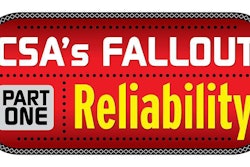
About to catch your breath because you’ve finally gotten the Compliance, Safety, Accountability program under control? Not so fast.
Regulatory compliance expert Jeff Davis, principle officer for Fleet Safety Services, told CCJ Summer Symposium attendees in LaJolla Calif., this morning that a virtual tsunami of regulations directly or indirectly related to CSA has begun to hit the trucking industry.
Even with “regulation fatigue” at the executive level, Davis maintains that truck fleets will have to redouble their efforts to stay ahead of the curve on CSA in order to protect their BASIC scores. Those numerical rankings are coming under increasing scrutiny by law enforcement and regulatory agencies, as well as shippers and insurance companies.
“We’ve come through Phase 1 of the CSA,” Davis explained, “which was the actual launch of the program and understanding how it would work. For better or worse, we now have that information. Now we’re entering Phase 2, which is the actual intervention phase, which CSA was all about in the first place.”
In other words, Davis says, truckers must shift primary concerns from educating themselves about CSA to learning how to operate in a world largely defined by how the program views them. The process is made even more complicated by the way the program is being used — and abused — in ways it was never intended to.

Davis told Symposium attendees that he believes a primary internal purpose of CSA is to force carriers into using electronic logs. He maintains that use of e-logs is the only way fleets today can accurately track and control hours compliance to head off detrimental CSA scores.
Medical examiner registry adds hurdles
Drivers are now required to use doctors who are certified by the federal medical registry to renew a CDL or get a new one.
More annoying for back-office management, Davis says, is a requirement that requires the government-certified doctor to, in turn, be re-certified by the fleet as well.
“You have to place a note in the driver’s file that the doctor who passed him or her as fit for duty is government-certified,” he explained. “You have to go to the FCMSA website and verify they are certified. This regulation crept up on us and I had no idea it was even being considered until I ran up on it last week.”
Davis says fleets can expect a sleep apnea test to round out the medical certification process for drivers.
“The bottom line is that fleets are simply going to have to be more hands-on in helping their drivers get — and keep — their medical cards,” Davis adds. “It’s going to take more time, more resources and more people to do so.”
Hair drug testing on the way
Additionally, Davis believes that hair testing for the new driver drug and alcohol clearing house may soon be required. “My advice to fleets is to be proactive on this front now,” he stressed. “I recommend checking your database on every driver to ascertain whether they’ve had a prior drug or alcohol violation and follow up to make certain they are in compliance now.”









